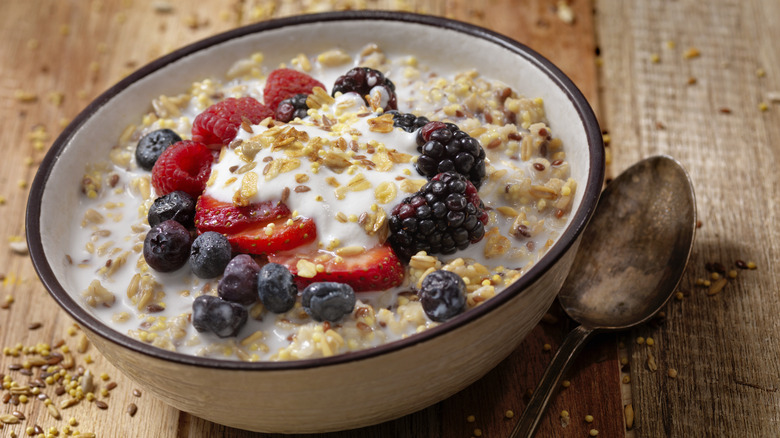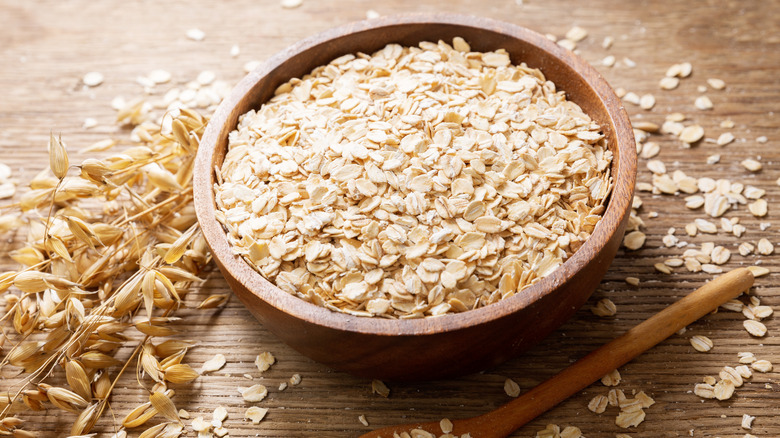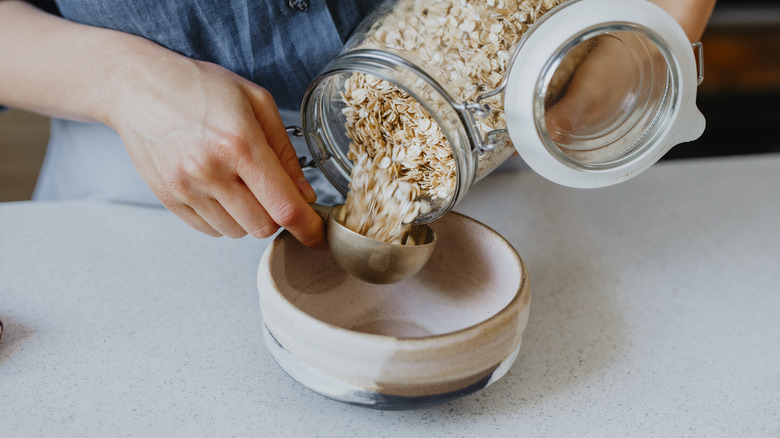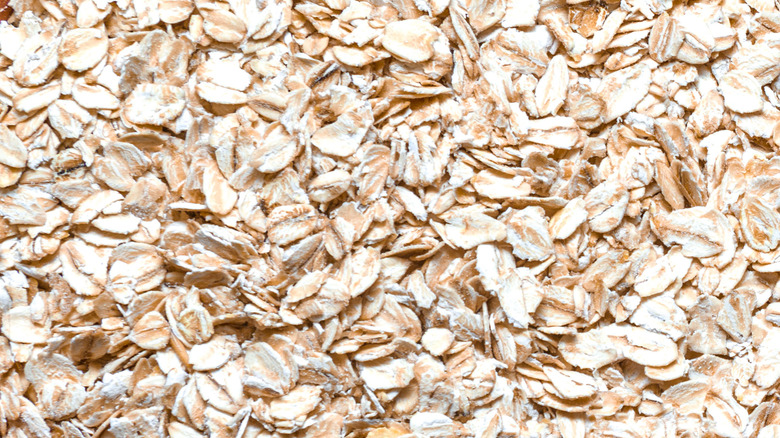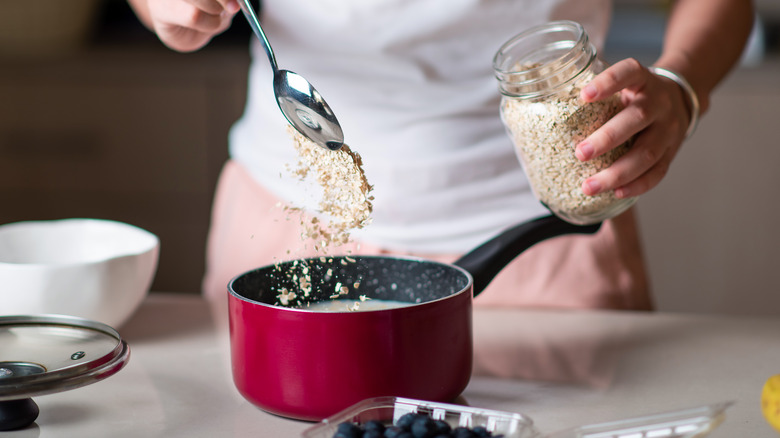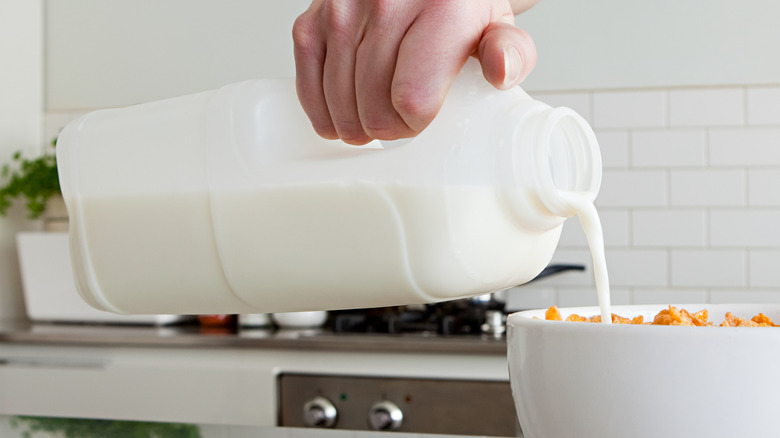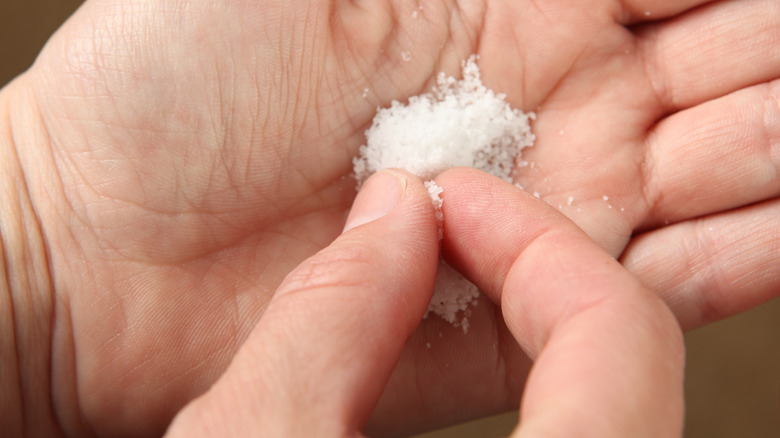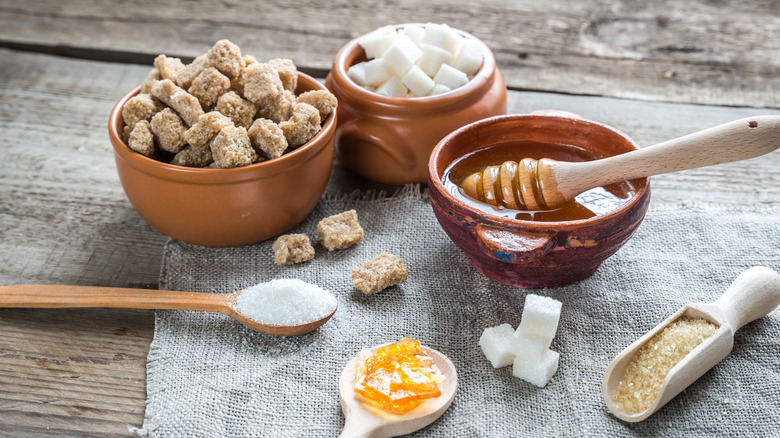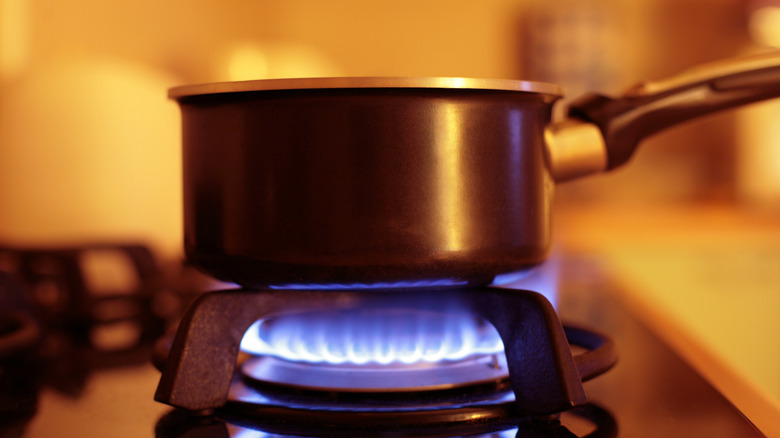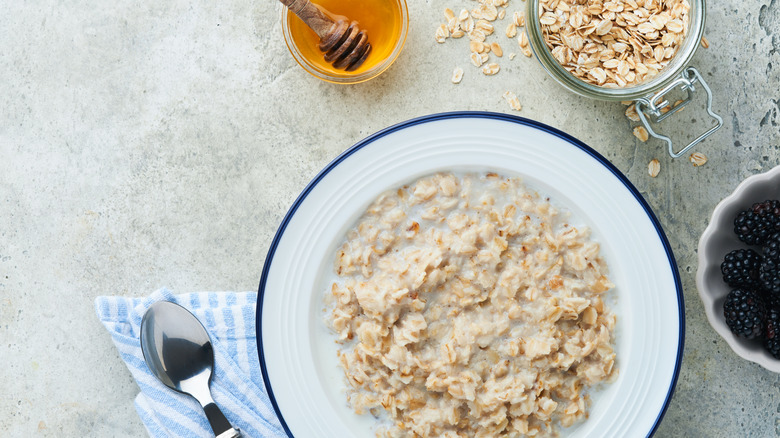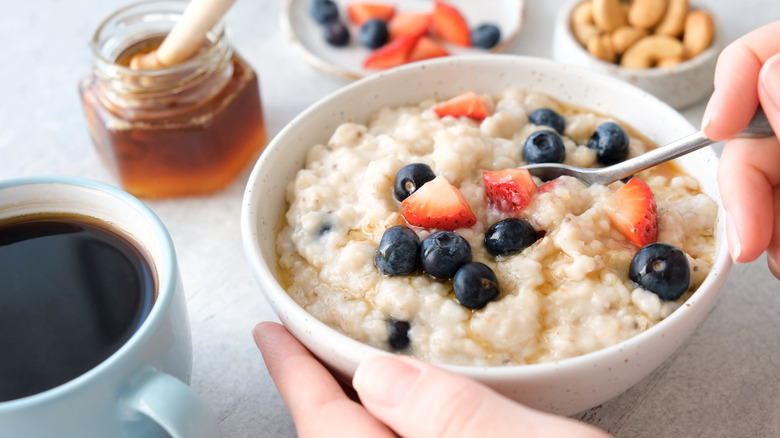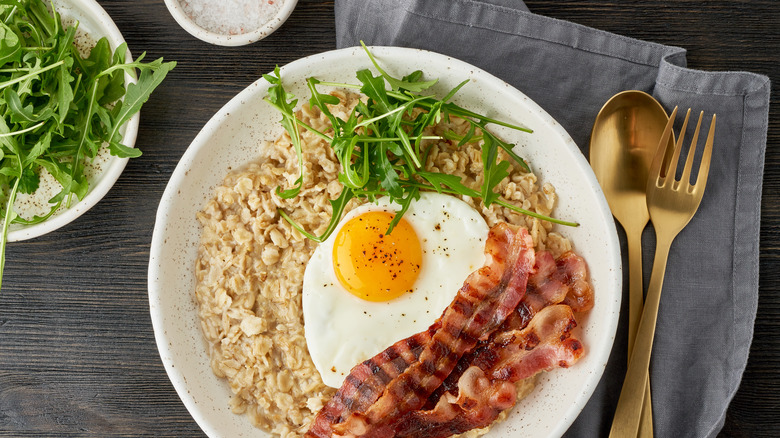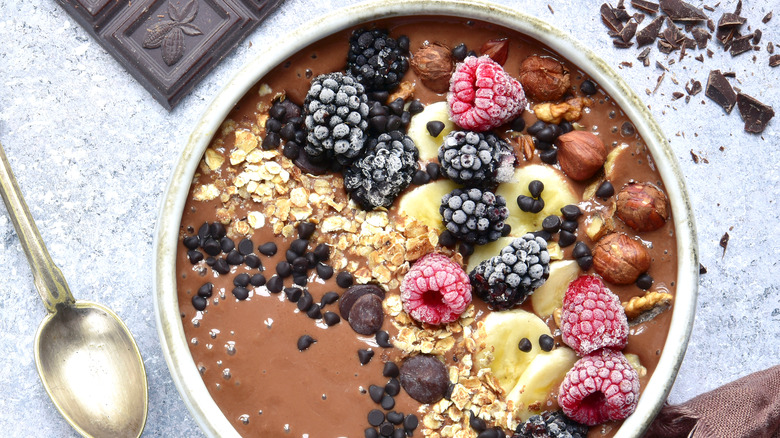Mistakes Everyone Makes When Cooking Oatmeal
When it comes to breakfast, few foods pack as much punch — or are as good for you overall — as a nice, hot bowl of oatmeal. This wholesome "superfood" is loaded with nutrients, including manganese, phosphorus, magnesium, copper, iron, zinc, folate, and more (via Healthline). Oats are also a rich source of fiber, protein, and disease-fighting antioxidants, according to the Journal of Cereal Science. And perhaps best of all, oatmeal isn't just good for you, it also tastes great. It's filling, it's affordable, and it's incredibly satisfying.
It also couldn't be easier to make. Simply pour 1 cup of rolled oats into a saucepan, add 2 cups of liquid, bring to a boil, and then let simmer for about five to 10 minutes until the oats are tender and the liquid has begun to thicken. Voilà, instant breakfast.
Yet even with a process this simple, making oatmeal isn't foolproof. If you're not careful, you can easily end up with a bowl of sludge that's dense and gummy, way too runny, incredibly bland, or that just tastes funky. Sound familiar? If your oatmeal game could use a little refinement, keep reading as we go through some of the most common mistakes everyone makes when cooking oatmeal, plus the culinary secrets you need to know to avoid these mishaps.
Using the wrong oats
The breakfast aisle can be a confusing place, filled with grains you aren't familiar with and ingredients you haven't tried before. Take oats, for example. While oats can sometimes be confused with wheat, quinoa, barley, and buckwheat, it's important to remember that these are all distinct grains. They are related, but each comes from a different type of grass-like plant.
When making oatmeal, always stick with products that are labeled as being 100% oat-based. The best oats for oatmeal are rolled oats — grains that have been steamed and then flattened with large rollers. Quick oats are another excellent oatmeal option. These grains are cut into small pieces, steamed, and then rolled flat. Finally, if you're especially short on time in the morning, consider instant oats, which cook even faster. To become "instant," these grains have been pre-cooked and dried before being packaged for sale.
Steel-cut oats are a growing trend for many health-conscious individuals, and you can use them for oatmeal, as well. Just keep in mind that they are minimally processed — cut into large pieces with steel blades but not pre-cooked or steamed. They also cook the most slowly and need to be soaked for several hours (or overnight) before you use them. Whole oats are the slowest cooking. They are essentially whole oatmeal grains or seeds, with their outer husk removed. They're also a poor choice for oatmeal. Use them for salads, risotto, or pilafs, instead.
Cooking old oats
Once you've decided what type of oatmeal you're going to make, it's important to consider just how fresh the oatmeal in your pantry is — especially if you don't go through containers of the grain that frequently. We're all guilty of letting some foods sit around longer than we might have intended, and oats can be especially prone to going bad before they've been used up.
Unopened, a box of any kind of oats will often last for one to two years before reaching its "best by" or "expiration" date. But once you pop that top, those oats should be used within six to 12 months for maximum flavor and freshness.
Not sure how old your oats are? Check their smell. The older oats get, the more likely they are to start smelling rancid. Fresh oats, in contrast, will have a neutral, slightly nutty flavor. Older oats may also experience a change in color or appearance. You might notice weird sheens or discoloration in oatmeal that has been around for an extended period. If your oats look odd in any way, don't eat them. Finally, if you've already cooked your oatmeal and notice any unusual flavors or weird clumpy, or gritty textures, those are two more signs your oats may be past their prime and need to be replaced.
Not toasting your oats
Many different types of grain, from quinoa to barley to sesame seeds, benefit from a quick "toasting" before being used in any recipe. Oatmeal is no exception. Of course, those untoasted grains can still be very tasty if you use them to make a big pot of fresh, hot, cooked oatmeal. But if you toast your oats in advance and then make your oatmeal, you'll notice a world of difference in your final dish.
Toasted oats have a much more intense, natural nutty flavor. They taste richer and more robust and have a much stronger aroma. Toasting also gives oats more firmness — it can create a subtle crunch that adds delightful texture and body to a bowl of cooked oatmeal.
The process for toasting grains of all types, including oats, is essentially the same. You can either spread your oats in a thin, even layer on a baking sheet and toast them in a 350 F oven for 10 to 15 minutes or until they turn a light, golden brown. Or, pour them into a dry skillet and toast on your stovetop over medium heat until they reach that same lovely, golden hue. If you use the stovetop method, just be sure to stir the grains frequently so they don't burn instead of toasting.
Following the wrong oat to liquid ratio
As we already mentioned, the basic oat-to-liquid ratio when preparing any bowl of cooked oatmeal is always approximately 2 cups of liquid to 1 cup of dry oats. However, there are a few adjustments to this formula that you should always keep in mind. The more processed (or finer cut) the oats you are using for your oatmeal, the less liquid they will require. So, if you're cooking instant or quick oats, you may want to dial back the amount of liquid you use slightly — especially if you enjoy a thicker, heartier bowl of cooked oatmeal.
Conversely, whole-rolled oats and steel-cut oats cook more slowly. They will absorb more moisture as they cook to become tender. Your saucepan will also allow more steam to escape as these oats are cooking. Because of this, you may need to use slightly more water to cook these types of oats into a satisfying oatmeal, especially if you like a looser, less chunky bowl of toasted breakfast goodness.
Using water alone to make your oatmeal
Cooking oats with plain water is a perfectly acceptable way to prepare your morning bowl of oatmeal. The mistake here isn't actually that you're doing anything wrong. Water is just a boring ingredient. And when you make oatmeal with water alone, you're going to get a dish that tastes like water and oatmeal — bland and dull, with a minimum of flavor or interest.
Fortunately, this is also easy to fix — just swap that water for something else. You can substitute that entire cup of water for a different liquid, or use a combination of 50% water and 50% something else. The choice is entirely yours, and you have an almost infinite number of liquids to pick from.
For a richer, creamier bowl of oatmeal, use milk in place of water. Or, try a plant-based option like almond, oat, or even hemp milk. For a sweeter bowl of oatmeal, try using apple juice or orange juice. You can even make oatmeal with coffee or tea. Hazlecut-flavored coffees pair incredibly well with oats and will make an exceptionally nutty and inviting bowl of oatmeal. As for tea, Earl Grey, chai, English breakfast, and green tea also all make extraordinary oatmeal additions, each bringing unique notes and flavors to the dish that you wouldn't get with any other liquid. Already made your oatmeal with water? Try topping it with a bit of flavored coffee creamer for more richness even after it's been prepared.
Skipping the salt
Adding salt to a sweet breakfast food like oatmeal seems counterintuitive to many of us, so we don't do it. But unless you're on a low-sodium diet and need to watch your salt intake, skipping the salt when making oatmeal can be a giant blunder that dramatically impacts the flavor of your final dish.
Even in foods you might consider "sweets," salt plays an essential role. That's why you often see it in the ingredient list for everything from rich cakes to decadent treats, like our Triple Chocolate Brownie Batter cookies. Salt enhances the natural flavor of all types of ingredients, including oats. It brings out sweetness and richness and creates a more well-rounded flavor overall. It also helps to balance flavors and adds savory elements to a dish, preventing it from being as one-dimensional. Finally, salt cleanses the palate and improves the textures of foods, making them seem even creamier and more satisfying. In other words, it plays a crucial role in creating many of the elements that make oatmeal so pleasing and satisfying, especially first thing in the morning.
You don't need a lot of salt to create this type of magic, either. Anywhere from ¼ to ½ teaspoon of salt will be plenty for an entire batch of oatmeal. Still, if you'd rather steer clear of added salt for any reason, you can create similar richness and robustness in the flavor of your oatmeal by stirring in some crushed nuts or freshly grated citrus zest.
Cooking without a sweetener
Just as holding salt from your oatmeal while it's cooking might seem a smart way to make the dish healthier, many of us also hold off on adding sweeteners to oats when they're in the saucepan softening. In theory, the choice makes sense. If you need additional sweetness, you can add it later on when the oatmeal is in your bowl — big mistake.
In reality, you get much better-tasting oatmeal when you add a tablespoon or more of sweetener to your oatmeal liquid while your oats are cooking. Letting the sweetener dissolve in hot water that's then absorbed into those oat grains creates a much more well-balanced breakfast. It promotes a more consistent and well-rounded sweetness in the oatmeal, infusing it with flavor throughout instead of the pockets of sweetness you get when you add sugar at the end. Adding sweeteners while oatmeal cooks also creates a more mellow sweetness in the dish. When eating your final cooked oatmeal, you may find that it is sweet enough and won't need to add additional sweeteners later on.
White sugar, brown sugar, honey, maple syrup, and agave nectar are just a few of the sweeteners you might add to oatmeal. To mix any of these options into a pot of oatmeal, simply measure out your sweetener of choice, dissolve it into the liquid in your saucepan, and then add your oats, stirring well so everything is evenly mixed. Then, let your oatmeal cook as you would normally.
Boiling instead of simmering
You've likely heard the terms boiling and simmering many times as you pursued various recipes, but the variation between these two cooking techniques is especially critical when it comes to making a simple dish like oatmeal. It can be the difference between oatmeal that is rich and nuanced in flavor (when you let it simmer) and oatmeal that is lumpy or chewy (when it has been boiled).
As a quick refresher, boiling occurs when a liquid reaches its boiling point (212 F at sea level). It causes vigorous bubbles in a liquid and a rapid, rolling movement. Simmering, in contrast, happens when liquids are heated to just under the point of boiling. It triggers much smaller bubbles and minimal movement in a liquid.
When you make oatmeal and let your liquid boil, the oats can develop all sorts of unusual textures. They're more prone to overcooking and may even stick to the bottom of your pot and burn if you aren't stirring frequently enough. Bringing the liquid in your oatmeal to a boil and then reducing heat and letting those grains simmer and soften more gradually, on the other hand, is much more gentle. It allows for more even cooking and creates better-tasting and more appealing oatmeal overall. Very few foods need to be cooked in rapidly boiling water, so whether you're making hard-boiled eggs, soup, or oatmeal, the rule of thumb is almost always "simmer, don't boil."
Ignoring added spices and seasonings
A sprinkle of cinnamon is a given for oatmeal. It adds warmth and perfectly complements the rich nuttiness of the dish. But cinnamon isn't the only spice or flavor enhancer you should harness in your oatmeal seasoning arsenal. There are plenty of other great options to try and enjoy, as well.
For instance, if you like cinnamon, nutmeg is another ideal option to add even more natural nutty complexity to the dish. Start with a tiny sprinkle — a little goes a long way — and then add more as needed to reach just the right level of flavor. You can also add cardamom, ginger, ground cloves, allspice, and even pumpkin pie spice to cooked oatmeal. All act similarly to cinnamon, bringing out sweetness and providing a robust, comforting warmth.
For something a bit different and unexpected in the morning, you might also consider adding turmeric, chai spice blend, ground anise, powdered vanilla, cocoa powder, or even fennel seed to your oatmeal. And don't forget that liquid flavorings used in baking can also be a wonderful way to boost the flavor of a potentially bland bowl of cooked oatmeal. You can use a drop or two of vanilla or almond extract, coffee or hazelnut flavoring, or even a small amount of rosewater to add sweet, floral notes and a lovely, delicate aroma of flowers to your oatmeal bowl.
Letting your oatmeal sit too long
From soups to freshly grilled cuts of meat, many things you can make in the kitchen benefit from a few minutes of rest or sitting undisturbed before you dig into them. But oatmeal is not one of these foods. For the best flavor and texture, any bowl of oatmeal should be served almost immediately after it has been cooked.
When you let oatmeal sit for too long, it can become overly dense, sticky, or pasty. It's also more likely to lose that delightful creaminess and chewiness that so many of us enjoy. The oats in your oatmeal can also absorb too much extra liquid as they rest, and this can leave you with thick, clumpy blobs in your bowl.
If you do need to let your oatmeal sit for a few minutes before you can eat it, try to stop cooking it just before the oats are perfectly tender. Residual heat in the bowl will help them to finish cooking. Also, include a bit of additional liquid in your bowl so those oats don't dry up and thicken too much as they wait to be eaten.
Adding fresh fruit to the oatmeal too early
While oatmeal is best when enjoyed still piping warm, it's another common mistake to add fruit to a bowl of freshly cooked oatmeal too soon. If you do, the oatmeal will start to cook your fruit and turn it slightly mushy, robbing you of that crisp freshness and vibrancy that makes fresh fruit such a great oatmeal topping.
To preserve the texture of fresh fruit mixed into oatmeal, always keep your fruit separate from your oatmeal and add it to your bowl just before you are ready to eat. Pick the freshest, firmest fruit possible. Keep your fruit whole or cut it into large pieces since smaller chunks will be more susceptible to heat damage. Serve the fruit on top of the oatmeal — don't mix or stir it into the bowl where it will be exposed to the oatmeal's heat for a prolonged amount of time.
Not trying savory oatmeal
Sure, oatmeal is amazing paired with brown sugar and cinnamon. But if you think oatmeal is solely a sweet and decadent morning option, this is one more oatmeal mistake you're likely making every morning. In truth, oatmeal is no different than bread, cereal, or any other food made from grain. It can be sweet. But it also tastes wonderful when it takes on a more savory form.
You can enjoy savory oatmeal in several different ways. For starters, try making it with chicken broth or flavorful stock instead of milk or juice. You can also load oatmeal up with shredded cheese and finely chopped herbs like basil or dill. Try sautéing some mushrooms or onions and folding those into a warm bowl of freshly made oatmeal. Mix in a dollop of pesto or a handful of diced sun-dried tomatoes, and finish your bowl off with a drizzle of your favorite olive oil.
To make an Asian-inspired oatmeal breakfast, pair your oatmeal with soy sauce, some nicely cooked spinach, and a sprinkle of sesame seeds. Try a Southwest-style bowl of oatmeal by adding black beans, corn, diced tomatoes, and a teaspoon of taco seasoning to your bowl and mixing well. Or go all out and fold crumbled bacon into your oatmeal and top it with a sunny-side-up egg. The options are endless.
Too many toppings
Ready to finally dig into that tasty bowl of warm, creamy oatmeal? Good. But as you start to dish it up, just remember the last mistake many of us make with this breakfast staple: too many toppings. Yes, oatmeal is incredible when paired with butter, brown sugar, fresh berries, chocolate chips, sliced bananas, or even a drizzle of chocolate syrup. But the dish itself is also especially mild and nutty, with just the right hint of earthiness. When you pile on too many different toppings, you can start to lose the wonderful "essence" of those oats and are just left with the taste of all your garnishes.
To avoid this common blunder, just pick one or two of the toppings you enjoy the most, and stick with them alone as the finishing touches on your oatmeal. Then, tomorrow, indulge in one or two different options. That way, you still get to enjoy the delightful taste of your morning bowl of oats — and you have something to look forward to each day as you cycle through all those incredible toppings that make each bowl even more delicious.

